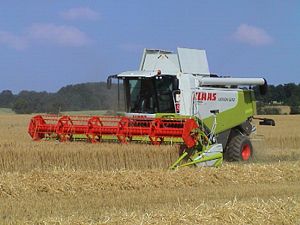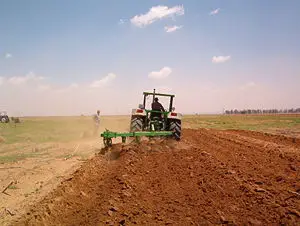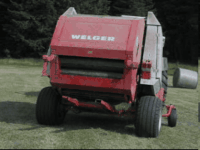Agricultural technology

Agricultural machinery is any type of machinery used on a farm to help with farming. It is among the most revolutionary and impactful applications of modern technology. The elemental human need for food has been a major factor in driving the development of agricultural machines. Over the last 250 years, advances in farm equipment have dramatically changed the way people are employed and produce their food worldwide. The best-known example of this kind is the tractor.
People who are trained to design agricultural machinery, equipment, and structures are known as agricultural engineers. They work in the context of agricultural production and processing and the management of natural resources. They may perform tasks such as planning, supervising, and managing the building of dairy effluent schemes, irrigation, drainage, flood and water control systems. In addition, they may perform environmental impact assessments and interpret research results. Some specialties include power systems and machinery design; structures and environmental science; and food and bioprocess engineering. They develop ways to conserve soil and water and to improve the processing of agricultural products.
Add:
Mechanized agriculture is the process of using agricultural machinery to massively increase farm output. In modern times, powered machinery has replaced many jobs formerly carried out by men or animals such as oxen and horses.
The history of agriculture contains many examples of tool use, but only in recent time has the high rate of machine use been at such a level.
The first pervasive mechanization of agriculture came with the introduction of the plow, usually powered by animals. It was invented in ancient Mesopotamia.
Current mechanized agriculture includes the use of airplanes, helicopters, trucks and tractors, among other vehicles.
History
The first person to turn from the hunting and gathering lifestyle to farming probably did so by using his bare hands, and perhaps some sticks or stones. Tools such as knives, scythes, and wooden plows were eventually developed, and dominated agriculture for thousands of years. During this time, almost everyone worked in agriculture, because each family could barely raise enough food for themselves with the limited technology of the day.
With the coming of the Industrial Revolution and the development of more complicated machines, farming methods took a great leap forward. Instead of harvesting grain by hand with a sharp blade, wheeled machines cut a continuous swath. Instead of threshing the grain by beating it with sticks, threshing machines separated the seeds from the heads and stalks.
These machines required a lot of power, which was originally supplied by horses or other domesticated animals. With the invention of steam power came the steam-powered tractor, a multipurpose, mobile energy source that was the ground-crawling cousin to the steam locomotive. Agricultural steam engines took over the heavy pulling work of horses, and were also equipped with a pulley that could power stationary machines via the use of a long belt. The steam-powered behemoths could provide a tremendous amount of power, both because of their size and their low gear ratios. Their slow speed led farmers to comment that tractors had two speeds: "slow, and darn slow."
Gasoline, and later diesel engines became the main source of power for the next generation of tractors. These engines also contributed to the development of the self-propelled, combined harvester and thresher, or combine for short. Instead of cutting the grain stalks and transporting them to a stationary threshing machine, these combines cut, threshed, and separated the grain while moving continuously through the field.
Types
Combines might have taken the harvesting job away from tractors, but tractors still do the majority of work on a modern farm. They are used to pull implements—machines that till the ground, plant seed, or perform a number of other tasks.
Tillage implements prepare the soil for planting by loosening the soil and killing weeds or competing plants. The best-known is the plow, the ancient implement that was upgraded in 1838 by a man named John Deere. Plows are actually used less frequently in the U.S. today, with offset disks used instead to turn over the soil and chisels used to gain the depth needed to retain moisture.
The most common type of seeder is called a planter and spaces seeds out equally in long rows, which are usually 2 to 3 feet apart. Some crops are planted by drills, which put out much more seed in rows less than a foot apart, blanketing the field with crops. Transplanters fully or partially automate the task of transplanting seedlings to the field. With the widespread use of plastic mulch, plastic mulch layers, transplanters, and seeders lay down long rows of plastic, and plant through them automatically.
After planting, other implements can be used to cultivate weeds from between rows, or to spread fertilizer and pesticides. Hay balers can be used to tightly package grass or alfalfa into a storable form for the winter months.
Modern irrigation also relies on a great deal of machinery. A variety of engines, pumps and other specialized gear is used to provide water quickly and in high volumes to large areas of land. Similar types of equipment can be used to deliver fertilizers and pesticides.
And, besides the tractor, a variety of vehicles have been adapted for use in various aspects of farming, including trucks, airplanes, and helicopters, for everything from transporting crops and making equipment mobile, to aerial spraying and livestock herd management.
New technology and the future
The basic technology of agricultural machines has changed little in the last century. Though modern harvesters and planters may do a better job or be slightly tweaked from their predecessors, the US$250,000 combine of today still cuts, threshes, and separates grain in essentially the same way it has always been done. However, technology is changing the way that humans operate the machines, as computer monitoring systems, GPS locators, and self-steer programs allow the most advanced tractors and implements to be more precise and less wasteful in the use of fuel, seed, or fertilizer. In the foreseeable future, some agricultural machines will be capable of driving themselves, using GPS maps and electronic sensors. Even more esoteric are the new areas of nanotechnology and genetic engineering, where submicroscopic devices and biological processes, respectively, are being used as machines to perform agricultural tasks in unusual new ways.
Agriculture may be one of the oldest professions, but the development and use of machinery has made the job title of farmer a rarity. Instead of every person having to work to provide food for themselves, less than 2 percent of the U.S. population today works in agriculture, yet that 2 percent provides considerably more food than the other 98 percent can eat. It is estimated that at the turn of the twentieth century, one farmer in the U.S. could feed 25 people, where today, that ratio is 1:130 (in a modern grain farm, a single farmer can produce cereal to feed over a thousand people). With continuing advances in agricultural machinery, the role of the farmer will become increasingly specialized.
List of farm equipment
Traction and power
- Tractor
- Crawler tractor / Caterpillar tractor
Soil cultivation
- Cultivator
- Chisel plow
- Harrow
- Spike harrow
- Drag harrow
- Disk harrow
- Plough
- Power tiller
- Rotary tiller
- Rototiller
- Spading machine
- Subsoiler
- Walking tractor
Planting
- Broadcast seeder (alternately: broadcast spreader or fertilizer spreader)
- Plastic mulch layer
- Potato planter
- Seed drill
- Air seeder
- Precision drill
- Transplanter
- Rice transplanter
Fertilizing & Pest Control
- Fertilizer spreader, see broadcast seeder
- Terragator
- Manure spreader
- Sprayer
Irrigation
Harvesting / post-harvest
- beet harvester
- Bean harvester
- Combine harvester
- Conveyor belt
- Corn harvester
- Cotton picker
- Forage harvester (or silage harvester)
- Huller
- Potato digger
- Potato harvester
- Sickle
- Swather
Hay making
- See also: hay
- Bale mover
- Baler
- Conditioner
- Hay rake
- Hay tedder
- Mower
Loading
- Backhoe
- Front end loader
- Skid-steer loader
Other
A restored JCB 3C MkII, showing the conventional arrangement of front loader and backhoe
- Grain auger
- Feed grinder
- Grain cart
- Rock picker
See also
ReferencesISBN links support NWE through referral fees
- Yeoshua, Shimshon Ben. 2005. Environmentally Friendly Technologies for Agricultural Produce Quality. Boca Raton, FL: Taylor & Francis. ISBN 0849319110.
- Field, Harry L. and John Solie. 2007. Introduction to Agricultural Engineering Technology: A Problem Solving Approach. New York, NY: Springer. ISBN 0387369139.
- Hurst, Douglas R. 1991. Agricultural Technology in the Twentieth Century. Manhattan, KS: Sunflower University Press. ISBN 0897451465.
External links
All links retrieved September 21, 2007.
- American Society of Agricultural and Biological Engineers Official Site
- International Academic Programs in Agricultural, Food,or Biological Engineering
- Department of Biosystems and Agricultural Engineering-Michigan State University
Credits
New World Encyclopedia writers and editors rewrote and completed the Wikipedia article in accordance with New World Encyclopedia standards. This article abides by terms of the Creative Commons CC-by-sa 3.0 License (CC-by-sa), which may be used and disseminated with proper attribution. Credit is due under the terms of this license that can reference both the New World Encyclopedia contributors and the selfless volunteer contributors of the Wikimedia Foundation. To cite this article click here for a list of acceptable citing formats.The history of earlier contributions by wikipedians is accessible to researchers here:
- Agricultural_technology history
- Agricultural_engineering history
- Mechanised_agriculture history
- List_of_agricultural_machinery history
The history of this article since it was imported to New World Encyclopedia:
Note: Some restrictions may apply to use of individual images which are separately licensed.

